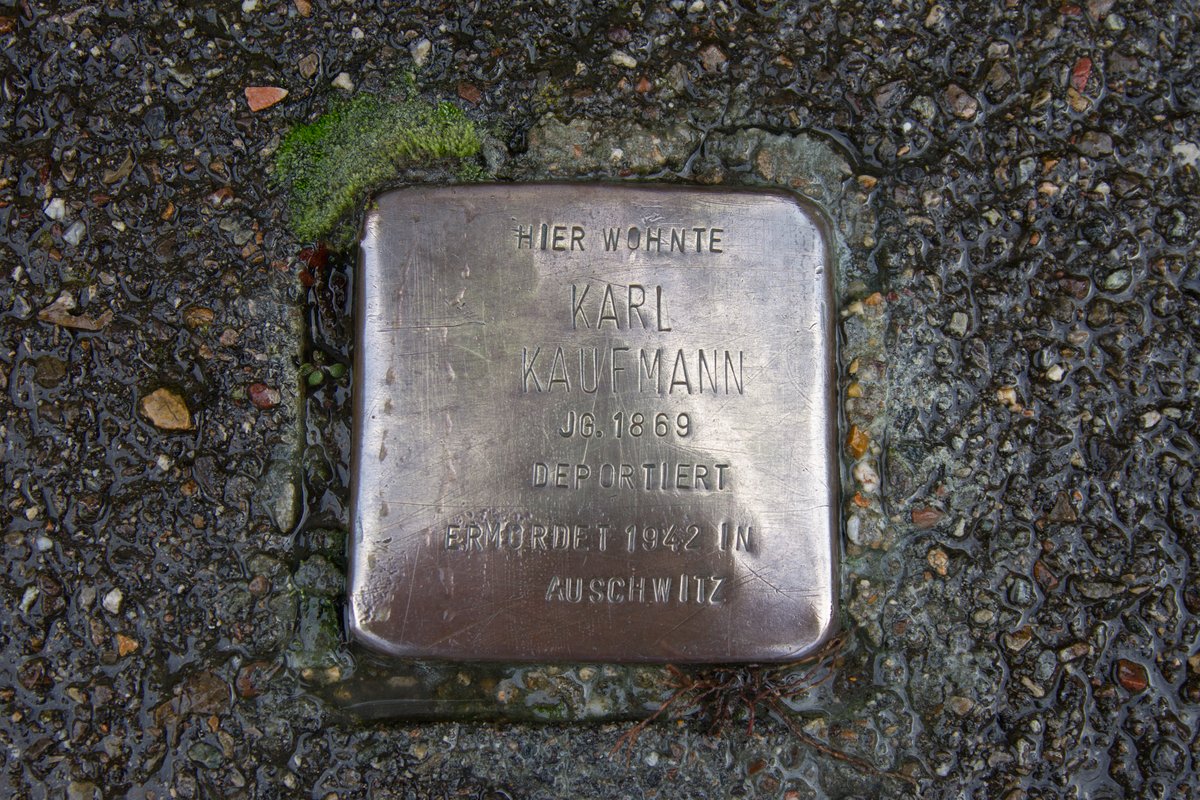
Stolperstein Karl Kaufmann Stuttgart: Visiting Hours, Tickets, and Historical Significance
Date: 14/06/2025
Introduction
Visiting the Stolperstein dedicated to Karl Kaufmann in Stuttgart, Germany, offers a deeply meaningful and educational connection to the city’s history under National Socialism. As part of the world’s largest decentralized memorial project, Stolpersteine—initiated by artist Gunter Demnig—commemorate individual victims of Nazi persecution. With over 1,000 stones in Stuttgart, including the one for Karl Kaufmann at Straußweg 41 in Stuttgart-Ost, these memorials restore personal identity to those lost in historical statistics and serve as catalysts for civic engagement and remembrance (Stolpersteine Stuttgart; Stolpersteine.eu; Stuttgarter Zeitung).
This guide provides a comprehensive overview of Karl Kaufmann’s Stolperstein, the project’s significance, practical visiting details, and how visitors can engage meaningfully with this vital part of Stuttgart’s cultural and historical landscape.
Table of Contents
- Overview of the Stolperstein Project
- Karl Kaufmann: Life, Persecution, and Commemoration
- Historical Context: Stuttgart under National Socialism
- Visiting Stolpersteine in Stuttgart
- Cultural and Educational Context
- Frequently Asked Questions (FAQ)
- Conclusion and Visitor Tips
- References & Further Reading
Overview of the Stolperstein Project
The Stolperstein (“stumbling stone”) project, started in 1992 by Gunter Demnig, is a decentralized memorial initiative honoring individuals persecuted and murdered by the Nazi regime between 1933 and 1945. Each Stolperstein is a small, brass-plated cobblestone set into the sidewalk in front of a victim’s last freely chosen residence. The stone is engraved with the person’s name, birth year, fate, and, if known, date and place of death (Stolpersteine.eu).
With over 116,000 stones in 31 countries, the project’s principle—“one stone, one name, one person”—restores individual dignity to those often reduced to numbers. In Stuttgart, more than 1,000 Stolpersteine have been installed, each representing a unique story of suffering, resistance, or survival (Stuttgarter Zeitung).
Karl Kaufmann: Life, Persecution, and Commemoration
Karl Kaufmann, born in 1869 to Jewish parents, lived at Straußweg 41 in Stuttgart-Ost. On August 22, 1942, he was deported to Theresienstadt and subsequently to Auschwitz, where he was murdered. His Stolperstein is inscribed:
HIER WOHNTE
KARL KAUFMANN
JG. 1869
DEPORTIERT
ERMORDET 1942 IN AUSCHWITZ
This memorial stone is the result of research by local historians and the “Gegen das Vergessen: Stolpersteine für Stuttgart” initiative, ensuring that Karl Kaufmann’s story, like so many others, is not forgotten (Stolpersteine Stuttgart).
Historical Context: Stuttgart under National Socialism
Stuttgart was a center of persecution during the Nazi era, targeting Jewish residents, political dissidents, Sinti and Roma, LGBTQ+ individuals, and people with disabilities. Mass deportations began in 1941, sending thousands to concentration and extermination camps (Stuttgarter Zeitung). The Gestapo’s strong local presence led to countless arrests and executions, forever altering the city’s social fabric.
Visiting Stolpersteine in Stuttgart
Finding Stolpersteine
- Location: Karl Kaufmann’s Stolperstein is at Straußweg 41, Stuttgart-Ost (Map Overview).
- Resources: Use the Stolpersteine Stuttgart interactive map for locations citywide. Guided walking routes and mobile apps are available.
Visiting Hours & Tickets
- Accessibility: Stolpersteine are public memorials embedded in sidewalks and can be visited 24/7, year-round.
- Fees: There is no admission fee; visits are always free of charge.
Guided Tours & Accessibility
- Guided Tours: Several organizations, including Hotel Silber e.V., offer guided walks with historical context and personal stories. Advance booking is recommended.
- Accessibility: Most Stolpersteine are on public sidewalks and accessible to those with mobility aids, though some streets may have uneven pavement. Check tour details for specific accessibility information.
Nearby Historical Sites and Events
- Hotel Silber: Former Gestapo headquarters, now a memorial and education center (Hotel Silber).
- Stuttgart Synagogue Memorial: Commemorates the city’s Jewish community.
- Annual Events: Commemorations on Holocaust Remembrance Day (January 27) and Kristallnacht anniversary (November 9) include ceremonies and Stolpersteine cleaning (SWR Aktuell).
Cultural and Educational Context
Stolpersteine are more than memorials; they are “social sculptures” that integrate remembrance into daily life. Community involvement is central: volunteers, school groups, and descendants research biographies, organize ceremonies, and maintain the stones (Stolpersteine Stuttgart). Initiatives like “Die Menschen hinter den Namen” share individual stories, deepening public understanding and engagement (StolperKunst Art Initiative).
Frequently Asked Questions (FAQ)
Where is Karl Kaufmann’s Stolperstein?
At Straußweg 41, Stuttgart-Ost. Use the interactive map for directions.
When can I visit?
Any time—Stolpersteine are accessible 24/7, year-round.
Are there entrance fees or tickets?
No, visits are free of charge.
Are guided tours available?
Yes. Check with local organizations or Hotel Silber for schedules.
Is the site wheelchair accessible?
Most Stolpersteine are on public sidewalks and generally accessible. Some pavement may be uneven.
Can I clean the stones?
Yes, gently cleaning with water and a soft cloth is a respectful act of remembrance.
May I take photographs?
Yes, but please respect local residents.
Conclusion and Visitor Tips
Visiting the Stolperstein for Karl Kaufmann connects you to Stuttgart’s living memory of the Holocaust. These stones transform abstract history into personal reflection, promoting remembrance and civic responsibility. Visitors are encouraged to:
- Use interactive maps to locate Stolpersteine.
- Attend guided tours or commemorative events.
- Visit nearby memorials and museums for a deeper understanding.
- Participate in stone cleaning or remembrance ceremonies.
For a comprehensive experience, download the Audiala app for guided tours and up-to-date Stolpersteine information, and explore further educational resources online.
References and Further Reading
- Visiting the Stolperstein Memorials in Stuttgart: History, Significance, and Visitor Information (Stuttgarter Zeitung)
- Visiting the Stolpersteine in Stuttgart: History, Location, and Visitor Guide (Stolpersteine.eu), (Stolpersteine Stuttgart)
- Visiting Stolpersteine in Stuttgart: Hours, Tickets, and Historical Significance (SWR Aktuell), (Stuttgarter Nachrichten)
- Visiting the Stolperstein for Karl Kaufmann in Stuttgart: Hours, Location & Visitor Guide (Stolpersteine Stuttgart), (Hotel Silber)
- Stumbling Stones Holocaust Memorials (Folklife Magazine)
- StolperKunst Art Initiative (StolperKunst)















































